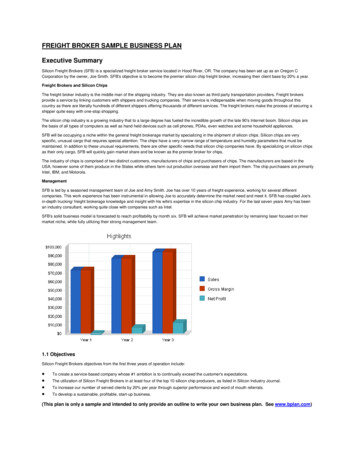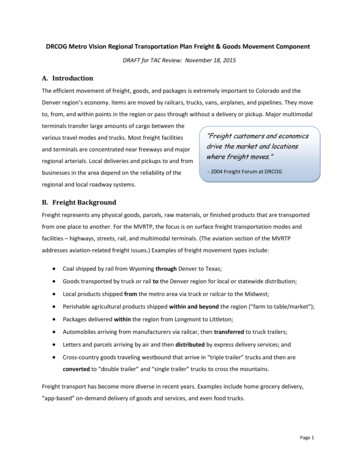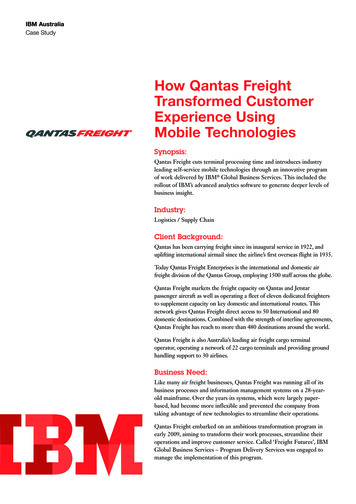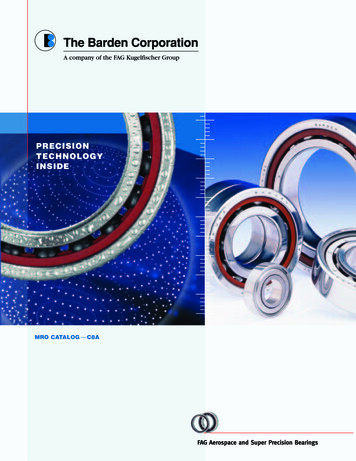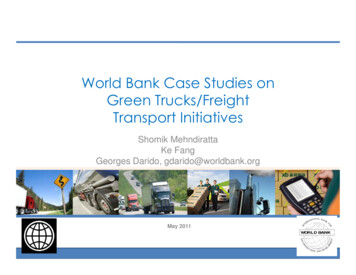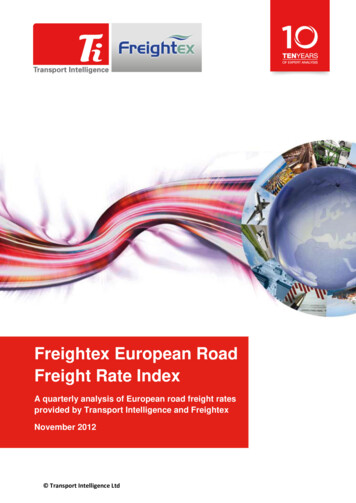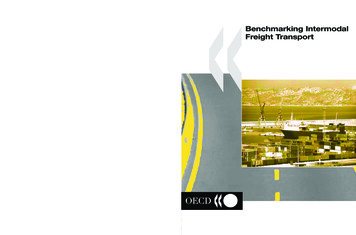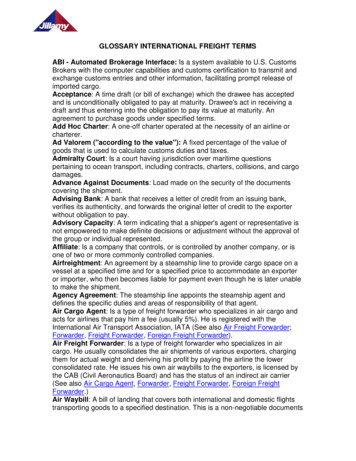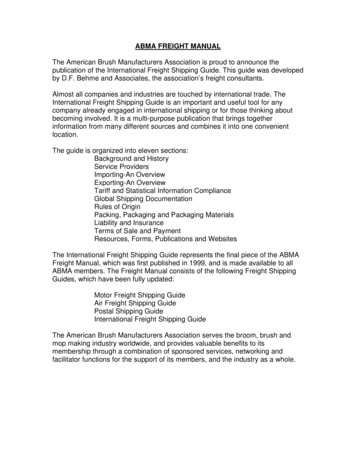
Transcription
ABMA FREIGHT MANUALThe American Brush Manufacturers Association is proud to announce thepublication of the International Freight Shipping Guide. This guide was developedby D.F. Behme and Associates, the association’s freight consultants.Almost all companies and industries are touched by international trade. TheInternational Freight Shipping Guide is an important and useful tool for anycompany already engaged in international shipping or for those thinking aboutbecoming involved. It is a multi-purpose publication that brings togetherinformation from many different sources and combines it into one convenientlocation.The guide is organized into eleven sections:Background and HistoryService ProvidersImporting-An OverviewExporting-An OverviewTariff and Statistical Information ComplianceGlobal Shipping DocumentationRules of OriginPacking, Packaging and Packaging MaterialsLiability and InsuranceTerms of Sale and PaymentResources, Forms, Publications and WebsitesThe International Freight Shipping Guide represents the final piece of the ABMAFreight Manual, which was first published in 1999, and is made available to allABMA members. The Freight Manual consists of the following Freight ShippingGuides, which have been fully updated:Motor Freight Shipping GuideAir Freight Shipping GuidePostal Shipping GuideInternational Freight Shipping GuideThe American Brush Manufacturers Association serves the broom, brush andmop making industry worldwide, and provides valuable benefits to itsmembership through a combination of sponsored services, networking andfacilitator functions for the support of its members, and the industry as a whole.
MOTOR CARRIERFREIGHT SHIPPING GUIDEOCTOBER 2002
M OTO R CARRIERFREIGHT SHIPPING GUIDEOCTOBER 20 0 2(Originally Issu ed Au gust 19 99 )Published byD. F. Behme and AssociatesAlbuquerque, NM
MOTOR CARRIER FREIGHT SHIPPING GUIDEis a copyright ed publication t hat is w hollyow ned by D. F. Behme and Associat es,freight transportation consult ants to t heAmeri can Brush Man uf act urer s Assoc iat ion(ABMA). It is being published by ABMA anddistribut ed as a membership benefit to ABMAmembers through special agreement w ith D.F. Behme and Associates. Reproduction ofthis copyrighted publication, in whole or part,is prohibited. August 19 99 (Original) October 200 2 (1st Revision)American Brush Manufacturers Association2111 West Plum Street Suite 274Aurora, IL 60506Telephone: 630 -63 1-5 21 7Email: dparr@abma.orgWEB: ww w .abma.orgD. F. Behme an d A ssoc iat esP.O. Box 53086Albuquerque, NM 8 71 53 -30 86Telephone: 505 -29 9-0 61 5Email: dfbehme@behmeassociates.com
TABLE OF CONTENTSINTRODUCTIONSECTION 1 - HIST ORY OF REGULA TION OF MOTOR FREIGHT TRANSPORTATION SERVICESINTERSTAT E COMMERCE ACT . . . . . . . . . . . . . . . . . . . . . . . . . . . .MOTOR CARRIER ACT OF 1980 . . . . . . . . . . . . . . . . . . . . . . . . . . .NEGOTIA TED RA TES A CT OF 1993 . . . . . . . . . . . . . . . . . . . . . . . . .TRUCKI NG INDUST RY REGULA TORY REFORM A CT OF 1994 . . . . . . .INTERSTATE COM MERCE COMMISSION TERMINA TION A CT OF 1995.233446667888SECTION 2 - MOTOR CARRIER PRICINGTRUCKLOAD PRICING . . . . . . . . . . . . . . . . . . . . . . . . . . . .LESS-THAN-TRUCKLOAD PRICING . . . . . . . . . . . . . . . . . . .FREIGHT CLASSIFICA TION . . . . . . . . . . . . . . . . . . .CLA SS RA TE TARIFFS . . . . . . . . . . . . . . . . . . . . . . .LEGAL STATUS OF TARIFFS AND CLASSIFICATIONS . . . . . .CA RRIER PARTICIPA TION IN CLASSIFICA TIONS AND TA RIFFSPERSPECTIVE ON MOTOR CARRIER BUREAU RATES . . . . . . .UNIFORM BILL OF LADING . . . . . . . . . . . . . . . . . . . . . . . . . . . .DESIGNA TION OF RATES AND RULES . . . . . . . . . . . . . . .INSTRUCTIONS FOR COD SHIPMENTS . . . . . . . . . . . . . .INSTRUCTIONS FOR FREIGHT COLLECT SHIPMENTS . . . .VA LUE DECLARATIONS . . . . . . . . . . . . . . . . . . . . . . . .WA RNING ON LI ABILITY LIM ITA TION . . . . . . . . . . . . . . .WA RNING ON SHIPMENTS REQUIRING SPECIAL CA RE . . .HAZM AT CERTIFICATIONS . . . . . . . . . . . . . . . . . . . . . .DATE/TIME CERTAIN DELIVERIES . . . . . . . . . . . . . . . . . .HANDLING OF REFUSED OR UNDELIVERABLE SHIPMENTSDELIVERIES TO THIRD-PARTY LOCATIONS . . . . . . . . . . .CUSTOMIZED BILLS OF LADING . . . . . . . . . . . . . . . . . . . . . . . .MODIFIED UBLS . . . . . . . . . . . . . . . . . . . . . . . . . . . . . .SHIPPERS’ BILLS OF LADING . . . . . . . . . . . . . . . . . . . . .INDIVIDUA L BILLS OF LADING . . . . . . . . . . . . . . . . . . . .CLASSIFYING AND DESCRIBING FREIGHT . . . . . . . . . . . . . . . . .PERSPECTIV ES ON USE OF THE UBL . . . . . . . . . . . . . . . . . . . . .NEGOTIATED CONTRACTS AND AGREEMENTS . . . . . . . . . . . . .“ STANDARD” CONTRACTS AND AGREEMENTS . . . . . . . .FULLY NEGOTIATED CONTRACTS AND AGREEMENTS . . .1011111111111212121212131313131415161616SECTION 3 - TRANSPORTATION CONTRACTSSECTION 4 - FREIGHT SH IPPING RULESADV ERTISING M ATTER, DISPLA YS AND PREMI UM S SHIPPEDWITH PRIMA RY COMMODITIES . . . . . . . . . . . . . . . . . . . . . . . . . . . . 20ARRIVAL NOTICE AND NOTICE OF UNDELIVERED FREIGHT . . . . . . . . . . . . . . 20BASIS FOR RATES A ND CHA RGES . . . . . . . . . . . . . . . . . . . . . . . . . . . . . . . 20ABMA/D . F. Behme & Ass ociat esMotor Carrier Freight S hippi ng Guid eOctober 2002 (Revised)i
BILLS OF LADING . . . . . . . . . . . . . . . . . . . . . . . . . . . . . .BLIND SHI PMENT RULE . . . . . . . . . . . . . . . . . . . . . . . . . .COLLECTION OF FREIGHT CHA RGES AND PENALTIES FORNON-PAYM ENT OR LATE PAYM ENT . . . . . . . . . . .COLLECT ON DELIVERY (COD) SHIPMENTS . . . . . . . . . . . .CONSTA NT SURVEILLA NCE SERVICE . . . . . . . . . . . . . . . .CORRECTED BILLS OF LADING . . . . . . . . . . . . . . . . . . . . .CUBIC CA PACIT Y RULES . . . . . . . . . . . . . . . . . . . . . . . . .CUSTOMS OR IN-BOND FREIGHT . . . . . . . . . . . . . . . . . . .DA NGEROUS A RTICLES . . . . . . . . . . . . . . . . . . . . . . . . . .DENSITY BUMPING . . . . . . . . . . . . . . . . . . . . . . . . . . . . .DUA L DRIVER PROTECTIV E SERVICE . . . . . . . . . . . . . . . . .DUNNAGE . . . . . . . . . . . . . . . . . . . . . . . . . . . . . . . . . . .EQUIPMENT AND PERSONNEL DETENTION . . . . . . . . . . . .ESTIMA TED FREIGHT CHARGE QUOTATIONS . . . . . . . . . .EXCLUSIV E USE OF VEHICLES AND/OR TRAILERS . . . . . . .EXPORT, COASTWISE OR INTERCOASTAL SHIPMENTS PLA CE OF DELIV ERY . . . . . . . . . . . . . . . . . . . . . . .EXTRA LABOR . . . . . . . . . . . . . . . . . . . . . . . . . . . . . . . .FEES AND FINES FOR OVERWEIGHT LOADS . . . . . . . . . . .FORK LIFT SERVICE . . . . . . . . . . . . . . . . . . . . . . . . . . . . .HANDLING SERVICE . . . . . . . . . . . . . . . . . . . . . . . . . . . .IMPRACTICAL OPERATIONS . . . . . . . . . . . . . . . . . . . . . . .INA DVERTENT A CCEPTA NCE RULES . . . . . . . . . . . . . . . . .LIABILITY LIMITS . . . . . . . . . . . . . . . . . . . . . . . . . . . . . .LIFT GATE SERVICE . . . . . . . . . . . . . . . . . . . . . . . . . . . . .LOADING BY CONSIGNOR AND UNLOADING BY CONSIGNEEMA RKING AND TA GGING FREIGHT . . . . . . . . . . . . . . . . . .MILEAGE GUIDES . . . . . . . . . . . . . . . . . . . . . . . . . . . . . .MINIMUM CHA RGES . . . . . . . . . . . . . . . . . . . . . . . . . . . .ABSOLUTE M INIMUM CHA RGE . . . . . . . . . . . . . . .SPECIFIC TRAFFIC MINIMUM CHA RGES . . . . . . . . .HA ZM AT M INIMUM CHA RGES . . . . . . . . . . . . . . . .CAPACITY LOA D M INIMUM CHA RGES . . . . . . . . . .MIXED PACKAGES . . . . . . . . . . . . . . . . . . . . . . . . . . . . .MIXED SHIPMENTS . . . . . . . . . . . . . . . . . . . . . . . . . . . . .NOTIFICATION PRIOR TO DELIVERY . . . . . . . . . . . . . . . . .ORDER NOTIFY SHIPMENTS . . . . . . . . . . . . . . . . . . . . . . .OVER-DIMENSION FREIGHT . . . . . . . . . . . . . . . . . . . . . . .OV ERFLOW CHARGES . . . . . . . . . . . . . . . . . . . . . . . . . . .PACKAGING SPECIFICATIONS . . . . . . . . . . . . . . . . . . . . .PALLETIZED FREIGHT . . . . . . . . . . . . . . . . . . . . . . . . . . .HEAVY FREIGHT . . . . . . . . . . . . . . . . . . . . . . . . . .MA RKING/TA GGING PALLETIZED FREIGHT . . . . . . .PALLETIZED MIXED SHIPMENTS . . . . . . . . . . . . . .SHRINK-WRAPPED OR UNITIZED PALLET FREIGHT . .RETURN OF PALLETS OR CONTAINERS . . . . . . . . . .PAYMENT OR GUARANT EE OF CHARGES . . . . . . . . . . . . .PICKUP A ND DELIV ERY (PUD) CHA RGES . . . . . . . . . . . . . .PROHIBITED OR RESTRICTED ARTICLES RULES . . . . . . . . .PROOF OF DELI VERY . . . . . . . . . . . . . . . . . . . . . . . . . . . .APPLIED-FOR RATE INCENTIVES . . . . . . . . . . . . . .ABMA/D . F. Behme & Ass ociat esMotor Carrier Freight S hippi ng Guid e. . . . . . . . . . . . . 20. . . . . . . . . . . . . October 2002 (Revised)ii
FUEL SURCHARGES . . . . . . . . . . . . . . . . .CLASS RAT E APPLICA TION . . . . . . . . . . . .LTL FREIGHT TENDERED AS A TL SHIPMENTRECONSIGNM ENT OR DIVERSION RULES . . . . . . . .REDELIV ERY SERV ICES . . . . . . . . . . . . . . . . . . . .RETURN OF UNDELIVERED FREIGHT . . . . . . . . . . .SEALS A ND LOCKS A PPLIED TO V EHICLE . . . . . . .SINGLE SHIPMENT CHA RGES . . . . . . . . . . . . . . . .SORTING A ND SEGREGATION CHA RGES . . . . . . . .STOPOFFS . . . . . . . . . . . . . . . . . . . . . . . . . . . . .STORAGE CHARGES . . . . . . . . . . . . . . . . . . . . . .TRANSFER OF LADING . . . . . . . . . . . . . . . . . . . .TRANSPORTATION OF HAZMA TS . . . . . . . . . . . . .VEHICLES FURNISHED BUT NOT USED . . . . . . . . .WEIGHING A ND INSPECTION CHARGES . . . . . . . .WEIGHT VERIFICA TION CHA RGES . . . . . . . . . . . 840.SECTION 5 - LIA BILITY, LIA BILITY LIM ITS AND CA RGO LOSS AND DA MAGECARM ACK AM ENDMENTS TO THE ICA . . . . . . . . . . . . . . .LIABILITY UNDER THE ICCTA . . . . . . . . . . . . . . . . . . . . . .CARRIER ACTIONS REGARDING LIABILITY LIMITS . . . . . . .REGULATORY AGENCY AND COURT ACTIONS ON LIABILITYCARGO OR LOSS, DAM AGE OR SHORTAGE CLAIMS . . . . .PERSPECTIVE ON THE LIABILITY LIMIT DEBATE . . . . . . . . .SECTION 6 - OVERCHARGE AND UNDERCHARGE CLAIMSDEFINITION OF OVERCHARGE AND UNDERCHA RGESTA TUTES OF LIMITA TION . . . . . . . . . . . . . . . . .DUPLICA TE PAYM ENT OF FREIGHT BILLS . . . . . . .THE 180-DA Y STA TUTE OF LIMITA TION . . . . . . . .UNDERCHARGE BILLS - SPECIAL UPDATE . . . . . . .4242424344CREDIT REGULATIONS . . . . . . . . . . . . . . . . . . . . . . . . . . . . . . .ABUSE OF PENA LTY PROVI SIONS . . . . . . . . . . . . . . . . . . . . . . . .SERVICE CHARGES FOR LATE-PAYM ENT OF FREIGHT BILLSRECOVERY OF COLLECTION EXPENSE CHA RGES . . . . . . . .STATUS OF THE “ LATE-PAYMENT” LOSS OF DISCOUNT PENALTYTHE HUM BOLDT COURT PROCEEDINGS . . . . . . . . . . . . . . . . . . . .PERSPECTIV E ON MOTOR CA RRIER CREDIT RULES . . . . . . . . . . . .47484849494950SECTION 7 - CREDIT RULES AND NON-PAYM ENT PENALTIESSECTION 8 - CERTIFICATIONS, DECLARATIONS, FORMULA S AND OTHER REQUIREMENTSAFFECTING RATE APPLICA TIONBUMPING . . . . . . . . . . . .DENSITY BUMPINGWEIGHT BUMPINGDECLARATIONS . . . . . . .MIXED SHIPMENTS . . . . .ABMA/D . F. Behme & Ass ociat esMotor Carrier Freight S hippi ng Guid e.5252535354October 2002 (Revised)iii
COMMON FORMULA S . . . . . . . . . . . . . . . . . . . . . . . . . . . . . . . . . . . . . . . . 55PACKAGING CRITERIA . . . . . . . . . . . . . . . . . . . . . . . . . . . . . . . . . . . . . . . . 55SECTION 9 - OUTSOURCING. . . . . . . . . . . . . . . . . . . . . . . . . . . . . . . . . . . . . . . . . . .57SECTION 10 - 50 FREIGHT SHIPPING TIPS. . . . . . . . . . . . . . . . . . . . . . . . . . . . . . . . .60GLOSSARY. . . . . . . . . . . . . . . . . . . . . . . . . . . . . . . . . . . . . . . . . . . . . . . . . . . . . . .64APPENDIX A - SUMM ARY OF KEY PROVISIONS OF SELECTED DEREGULA TION LEGISLATIONAPPENDIX B - SUMM ARY OF BILL OF LADING CONTRACT TERMS A ND CONDITIONSAPPENDIX C - CONT RACT CHECKLISTAPPENDIX D - OVERCHARGE/UNDERCHARGE CLAIM LIMITS FOR INTRASTATE SHIPMENTSAPPENDIX E - INFORMA TION ON STATE SMALL CLAIMS COURT REQUIREMENTSAPPENDIX F - THE U.S. COURT SYSTEMABMA/D . F. Behme & Ass ociat esMotor Carrier Freight S hippi ng Guid eOctober 2002 (Revised)iv
MOTOR CARRIER FREIGHT SHIPPING GUIDEINTRODUCTIONAll freight, at one point or another, is transported on a truck. Because motor carr iers play such apervasive role in freight transportation, this guide is dedicated to providing an overview of thoseservices and their use.The guide includes a brief history of motor carrier freight tr ansportation regulation and its evolutionto its present state. The primary focus is the current regulatory scheme and its impact on systemusers. Service, pricing and contracting are discussed along with other issues with which thecontemporary freight transportation distribution and procurement function is involved.The guide is written for a diverse readership. It provides upper-level management and corporateofficers a knowledgeable overview of the transporta tion procurement and distribution function.This facilitates planning, supervision and administration. It can be an integral part of any trainingprogram for supervisory and new employees. Finally, it contains information that, if properlyapplied, helps control freight transportation and distribution costs.ABMA/D . F. Behme & Ass ociat esMotor Carrier Freight S hippi ng Guid eOctober 2002 (Revised)1
SECTION 1HISTORY OF REGULATION OFMOTOR FREIGHT TRANSPORTATION SERVICESThe nation’s freight transportation industry originally was not regulated. Regulation first occurredover 100 yea rs ago, when railroads were subject ed to economic regula tion because of perceivedabuses of monopolistic power. Motor carriers came under the regulatory umbrella in 1935.Regulation was absolute, addressing both the economic and safety aspects of carriers’ operations.INTERSTATE COMM ERCE ACTThe primary regulator of the motor carrier freight tra nsporta tion industry has always been thefederal government. The Interstate Commerce Act (ICA) provides the authority and it extends toall interstate (between states) services and operations. Authority was exercised by the InterstateCommerce Commission (ICC) in the past.State governments imposed regulations also butcontrol was limited to intrastate (within state) operations.Motor carriers were licensed, limited to serving named routes and geographic areas, limited tohauling specific commodities, and were subject to a common carrier service obligation. A carriercould not decline service to any shipper, requesting service for commodities the carrier wasauthorized to haul, within the geogr aphic territory it was authorized to serve.Pricing was rigidly controlled. Ultimately the industry was granted antitrust immunity allowingit to collectively set rates for all services. A system of motor car rier tariff bur eaus served as themechanism for accomplishing collective ratemaking. Each bureau was responsible for a specificgeographic territory.All rates were published in bureau-issued tariffs, were filed with the ICC, and were available tothe public. A structure of class and commodity rates was developed, based on a freightclassification rating system. A filed rate doctrine, holding that deviations from published rateswere illegal and resulting charges uncollectible, was strictly enforced.Transporta tion contracts were allowed, but only under the most limited circumstances. They hadto be filed with the ICC and all contracts were subject to public disclosure. Motor contract carrierscould only serve a few shipp ers and could haul just a few commodities. Minimum shippingvolumes were prescribed thus limiting contracts to only the highest volume shippers.States exercised virtually identical regulatory control over intrastate carrier service. Stateregulation was typically administered and enforced by either specially designated commissions orby public utilities commissions.The trade-off for all of this regulator y control was pricing and ser vice stability. Similarly situatedshippers were assessed identical class or commodity rates and afforded identical service.Competition among carriers was almost nonexistent.ABMA/D . F. Behme & Ass ociat esMotor Carrier Freight S hippi ng Guid eOctober 2002 (Revised)2
MOTOR CARRIER ACT OF 1980The Motor Carrier Act of 1980 (MCA) changed all of this. The MCA began the process ofderegulating the motor carrier industr y and creating a more competitive environment. While theMCA did not completely deregulate motor ca rriers, it opened the doors significantly. The twomost important deregulation gains resulting from the MCA were (1) removal of barriers to entryinto service and (2) the introduction of limited pricing freedoms.Before the MCA, motor carriers went through a complicated process to obtain service rights.Carriers serving the routes and hauling the commodities a new entrant filed to serve, would opposethe new entrant’s application. The process was so draconian that few new entra nts could eversatisfactorily demonstrate a public need for their service. Competition was stifled.The MCA did not totally deregulate entry but it changed the process considerably. Ultimately anycarrier meeting minimum insurance requirements, and demonstrating it was fit, willing and able,was allowed to provide service. Territorial and commodity restrictions were lifted. Thousands ofnew carriers began operation and existing carriers expanded their service.The MCA also eased some pricing restrictions. The antitrust immunity, allowing collectiveratemaking, was condensed. For the first time, carriers were allowed to publish and file rates andrules for their own individual use. Bureaus were specifically precluded from interfering withindependent carrier rates and rules. While all rates still were filed with the ICC, and the filed ratedoctrine applied, for the first time deviation from bureau rates and rules was allowed. Individualcarriers immediately began developing their own pricing.While the new pricing freedoms were welcomed, they did not lead to a more simplified pricingsystem. The old system involving classification ratings survived. Carriers exercised theirindependent pricing freedom by offering discounts off bureau rates.NEGOTIATED RATES ACT OF 1993The controversy over the idea of total deregulation of motor carriers continued. Some favored totaleconomic deregulation while others favored limited oversight. Politicization of the ICC resultedin its issuing some ill-conceived and legally flawed regulatory decisions. It believed its decisions,administrat ively deregulating motor carriers, bypassed the need for Congressional legislative. Themost questionable of these caused many shippers and carr iers to believe the filed rate doctrine didnot apply under certain circumstances.In the meantime, economic downturns and production fa lloffs, which shrunk the quantity of fr eightavailable for hauling, combined with tremendous industr y expansion, to create over-capacity. Thisin turn began to drive rates down rapidly and, in some cases, to levels that were not profitable.Thousands of motor carriers were driven into bankruptcy. New companies were among the firstvictims but they were quickly followed by carriers that were industry leaders.Bankruptcy trustees, in keeping with their responsibilities, began casting about for ways to recoverfunds to pay off creditors. T hey immediately focused on the ICC’s flawed filed rate doctrinepronouncements, taking note of the approximately one million discounted rates that had never beenproperly published and/or filed with the ICC. The U.S. Supreme Court overturned the ICC’srulings and the undercharge claim crisis was in full swing. Shippers found themselves collectivelyABMA/D . F. Behme & Ass ociat esMotor Carrier Freight S hippi ng Guid eOctober 2002 (Revised)3
paying hundreds of millions of dollars, in additional freight charges, for shipments transported upto five years before the given carrier went bankrupt. Estimates are that more than 1.5 billion wascollected.The undercharge crises led to the Negotiated Rates Act of 1993 (NRA). The NRA put into placea series of defenses that shippers could use against undercharge claims. It established new criteria,which if met, allowed the undercharge claim to be dismissed or settled using a specific formula.The NRA reduced the statute of limitations applicable to overcharge and undercharge claims totwenty-four and then to eighteen months. It addr essed some new rate practices that had emergedin the semi-deregulated freight pricing world, allowing some and prohibiting others.TRUCKING INDUSTRY REGULATORY REFORM ACT OF 1994The Trucking Industry Regulatory Reform Act (TIRRA) eliminated the requirement thatindividually determined rates had to be published in ta riffs and filed with the ICC. This had theeffect of eliminating the filed rat e doctrine as it applied to individually determined rates.Collectively determined rates, those set using the antitrust exemption, still had to be published andfiled. TIRRA further eased entry into service. A carrier only needed to demonstrate safety fitnessand the ability to meet minimum financial responsibility requirements. It reduced the statute oflimitations on undercharge and overcharge claims to six months which ended most but not allundercharge claims filed on behalf of bankrupt motor carrier estates.TIRRA accomplished about 85% deregulation of motor car riers, but it contained a number ofstatutory anomalies that created difficulties. For example, while it effectively deregulated motorcommon carriers, it left rigid regulations in effect for motor contract carriers. Common carriershad service and pricing freedoms while contr act carriers were still restricted. Anothercontradiction, negotiated rat es were left susceptible to rate reasonableness challenges. Generallythese were individually determined rates that were not publicly disclosed. It was extremelyunlikely that the shipper that negotiated the rates would then turn around and file a reasonablenesschallenge to its own negotiated pricing.INTERSTATE COM MERCE COMMISSION TERMINATION ACT OF 1995Because of the gray ar eas left by TIRRA and a desire to totally deregulate motor carriers, theInterstate Commerce Commission Termination Act (ICCT A) was enacted. It accomplished 98%deregulation of the nation’s motor carriers. It abolished the ICC and created the SurfaceTransporta tion Board (STB). All sa fety regulation was tra nsferred to the U.S. Department ofTransportation (DOT).Motor carriers were left with a very limited antitrust exemption under which they set joint ratesand rates applicable to noncontiguous traffic (freight moving between the continental U.S. andHawaii, Alaska, and U.S. possessions and territories). They also use the immunity to accomplishfreight classification and to enact general rate increases to bureau r ates . Credit, cargo claim andliability, and over charge and undercharge regulations are the only economic regulations of anyconsequence that remain in effect. They appear minimal but manage to work their mischief as willbe seen.ABMA/D . F. Behme & Ass ociat esMotor Carrier Freight S hippi ng Guid eOctober 2002 (Revised)4
Intrastate regulation of motor carriers has declined in direct correlation to federal regulations. Nostate is allowed to impose regulations tha t are more stringent than federal regulations unless motorcarriers consent. This is a peculiar situation, as few if any motor carriers, would consent to anyform of economic regulation on a state level. Many states have opted for total deregulation.Safety regulations remain in effect at both federal and state levels. The federal government hasprimary jurisdiction while the states do most of the enforcement with the help of federal funds.Most states adopt federal safety regulations intact. Safety regulations focus on vehicles, equipmentand drivers. They address everything from types of reflectors on trucks to commercial drivers’licenses.The ICCTA, in keeping with what seems to have become a tradition with legislation to deregulatemotor carriers, managed to create some applicability gray areas which require court resolution orclarifying legislation. One of those areas involves the need for common vs. contract motor carr ierauthority. Another is concerned with the ability of carriers to unilaterally limit their liability in caseof cargo loss or damage. There are others, which has caused some shippers to get behind an effortto get Congress to enact clarifying legislation. Such legislation is not expected to occur muchbefore 2000, if at all.Summaries of the key provisions of the NRA, TIRR A and ICCTA are in Appendix A.ABMA/D . F. Behme & Ass ociat esMotor Carrier Freight S hippi ng Guid eOctober 2002 (Revised)5
SECTION 2MOTOR CARRIER PRICINGDespite all of the regulatory changes that have occurred in the industry since 1980, motor carr ierpricing is still based on and intimately tied to the pre-deregulation pricing system. The system oflinked freight classifications and tar iffs is firmly entrenched, but has been modified toaccommodate competitive pricing environments. Motor carrier pricing naturally breaks itself intotwo categories — truckload (TL) and less-than-truckload (LTL).TRUCKLOAD PRICINGTL pricing is the simplest. Generally, TL freight ra tes are mileage-based or are flat charges perload. In both cases, the commodity being hauled usually is not a factor when calculating finalfreight charges. Weight and distance are the primary considerations.Mileage-based rates are simply a charge per mile traveled. Sometimes there can be some caveatssuch as minimum or maximum distances, or minimum or maximum weights. Flat charges perload are just as simple. Minimum or maximum weights often apply and origin and destinationsare usually specified.LESS-THAN-TRUCKLOAD PRICINGLTL pricing is considerably more complex than TL pricing. Freight charges are developed froma combination of fa ctors including classification ra tings, shipment weight, density/cubage, originand destination. Two basic publications determine descriptions and rates for shipping LTL freightvia motor common and contract carriers. They are classifications and tariffs.Classifications and tariffs are interdependent and are legally binding on the carrier participating inthem and the shippers using those pa rticipa ting carr iers, unless they mutually agree to other terms.Freight classification is the core of the LTL pricing system so an understa nding of that process isrequired.FREIGHT CLASSIFICATIONClassifications are listings or catalogs of commodities, products and virtually anything thatcan be hauled by a truck. They describe the commodity and assign a numeric value, aclassification rating, to each.Classification ratings are devised by evaluation of specifically defined transportationcharacteristics. The primary characteristic is density, a measurement developed from thefreight’s weight and dimensions. Some other characteristics evaluated in this process arevalue (for purposes of assessing loss and damage risk) and handling/stowingcharacteristics.The classification evaluation produces what is known as a classification rating. Aclassification rating is a numeric value, not a dollar and cents value, as opposed to a classrate that is a dollar and cents va lue. Classification ratings range from Class 50 to ClassABMA/D . F. Behme & Ass ociat esMotor Carrier Freight S hippi ng Guid eOctober 2002 (Revised)6
500 with Class 100 being the average or norm. The other class ratings are multiples of100. For example, Class 500 is 500% of Class 100, or Class 77.5 is 77.5% of Class 100.Some 15,000 descriptions, with LTL classification ratings, are itemized in the curr entNational Motor Freight Classification (NMFC). They cover most, if not all, knowncommodities being shipped today.The NMFC is modified (descriptions and ratings changed or added) through a process inwhich shippers are allowed limited participation. Shippers may present arguments aboutproposed changes and can propose modifications. Final decision on any proposed changeor modification is made by motor carriers through their 100-carrier member NationalClassification Commit
owned by D. F. Behme and Associates, freight transportation consultants to the American Brush Manufacturers Association (ABMA). It is being published by ABMA and . DUPLICATE PAYMENT OF FREIGHT BILLS. 42 THE 180-DAY STATUTE OF LIMITATION . 43 UNDERCHARGE BILLS - SPECIAL UPDATE . 44 SECTION 7 - CREDIT RULES AND NON-PAYMENT PENALTIES .
